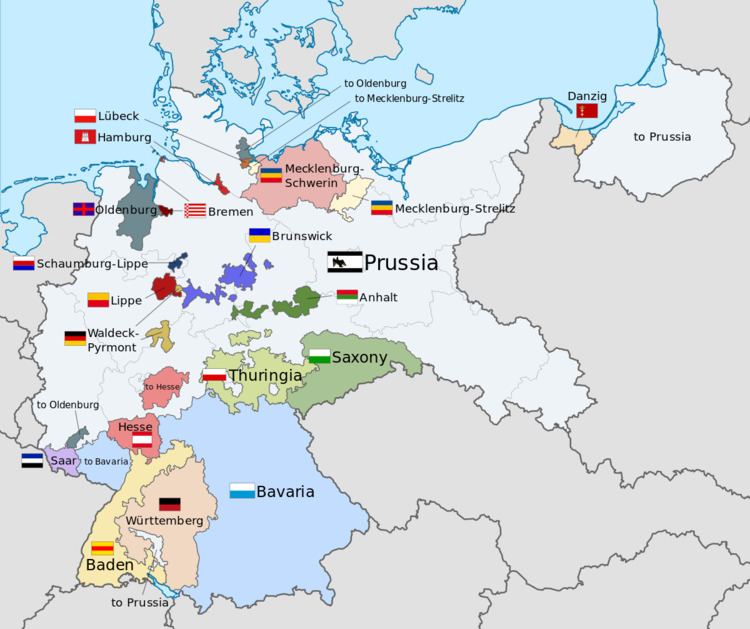 | ||
The Reichsstatthalter ( [ˈʁaɪçsˌʃtathaltɐ], Reich lieutenant) was a title used in the German Empire and later the Third Reich.
Contents
Statthalter des Reiches (1879–1918)
The office of Statthalter des Reiches (otherwise known as Reichsstatthalter) was instituted in 1879 by the German Empire for the areas of Alsace (Elsaß) and Lorraine (Lothringen) that France had ceded to Germany following the Franco-Prussian War. It was a form of governorship intended to exist while Alsace-Lorraine became a federal state of the Empire. It was abolished when Alsace-Lorraine was, in turn, ceded back to France after Germany lost World War I.
Third Reich
During the Third Reich, the Nazis created the office of Reichsstatthalter (Reich Governor or Reich Deputy) to gain direct control over the federal states (i.e., the states other than Prussia) after winning the general elections of 1933. Their independent state governments and parliaments were successively abolished, and the Reich government took over direct control in a process called Gleichschaltung ("coordination").
Two weeks after the passage of the Enabling Act of 1933, which effectively made Adolf Hitler the dictator of Germany, the Nazi government issued the Second Law for Synchronization of the States with the Reich (Zweites Gesetz zur Gleichschaltung der Länder mit dem Reich) on 7 April 1933. This law deployed one Reich Governor in each state. The Reich Governors were given the task of overseeing the fulfillment of Hitler's political guidelines in the states. Indeed, the law required them to carry out "the general policy of the Chancellor." In practice, they acted as proconsuls with complete authority over the state governments. The deputies' main authorities lay in:
In Prussia, the largest of the German states, where the government had been taken over by the Reich government a year earlier in the Preußenschlag, Hitler took direct control. However, he passed his authority to Hermann Göring, who had been installed as Prussian prime minister without an election. The Prussian provinces were administered by an Oberpräsident, usually the local Gauleiter.
Law for the Reconstruction of the Reich (1934)
The Law for the Reconstruction of the Reich (Gesetz über den Neuaufbau des Reiches) passed on 30 January 1934; formally de-federalized the Reich for the first time in its history. However, Germany had effectively become a highly centralized state with the passage of the Enabling Act and the posting of the Reich Governors. The states' powers were transferred to the Reich, and their parliaments were abolished. The Reich Governors were made responsible to the Reich Minister of the Interior, Wilhelm Frick. For all intents and purposes, the states were reduced to provinces.
Reich Governors Law (1935)
The Reich Governors Law (Reichsstatthaltergesetz) of 30 January 1935 named the Reich Governors the constant representatives of the Reich government, appointed to watch over the execution of the political guidelines issued by the Führer und Reichskanzler (Hitler). They received the authority to "inform" the provincial authorities about the guidelines and the measures to fulfill them. The Reichsstatthalter were now also empowered to take over all functions of state government, and also appointed the mayors of all towns and cities with populations fewer than 100,000.
Anschluss
After the Anschluss ("union") with Germany, Austria's last pre-war Kanzler became also its first Reichsstatthalter: 15 March 1938 – 30 April 1939 Arthur Seyss-Inquart (b. 1892 – d. 1946; NSDAP; also Führer der Österreichischen Landesregierung), be it most of his term besides a Reichskommissar für die Wiedervereiningung Österreichs mit dem Deutschen Reich 'Reich Commissioner for Reunification of Austria with the German Reich' (23 April 1938 – 31 March 1940 Josef Bürckel, b. 1895 – d. 1944, NSDAP); next each constitutive Land (some differences in borders- thus Burgenland was partitioned away) got its own Reichsstatthalter, generally the last Premier.
